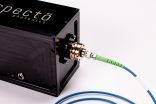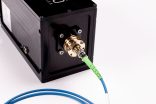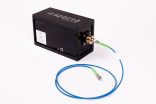BIPD filter for Brillouin spectroscopy
The BIPD filter from spectō photonics is a compact optical system for carrying out Brillouin spectroscopy. BIPD stands for “Birefringence-Induced Phase Delay,” i.e., phase shift induced by double refraction.
This component is used to suppress the elastic background light, which originates among other things from Rayleigh scattering. This enables the detection of very weak Brillouin effects. Thanks to its high suppression capability and robust construction, this device is the perfect choice for Brillouin spectroscopy.
Main features
- Ultra-high suppression of Rayleigh light
- Simultaneous measurement of Brillouin and Raman-THz
- Tunable in a wide wavelength range
- High stability for long measurements
Features
With its compact size of 10 cm x 8 cm x 17 cm and the concept of the common path, in other words the shared beam path, this filter can be conveniently integrated into existing microscope and spectrometer setups to perform Brillouin spectroscopy. The filter can be tuned to any laser frequency from VIS to NIR in less than a second, with a working wavelength between 450 and 900 nm. The BIPD filter can measure a frequency range of 0.1-100 cm-1, which covers the spectral range of Raman THz spectroscopy.
Applications of Brillouin spectroscopy
Brillouin spectroscopy enables non-destructive, label-free, and biomechanical characterization of subcellular structures in living cells. It can also be used to detect changes in response to external stimuli or intracellular liquid-to-solid phase transitions. Areas of application include, for example, the prevention of cardiovascular diseases and the diagnosis of cancer.
Technical background
How the BIPD filter works
The heart of the BIPD filter is the birefringent crystal in combination with the liquid crystal. When light passes through the birefringent crystal (aligned perpendicular to the direction of beam path at an angle of 45° to the input polarization), the light undergoes a phase shift depending on the wavelength. This results in a change in polarization. Since Brillouin and Rayleigh scattering have different polarizations, Rayleigh scattering can be suppressed using liquid crystal.
The following publication explains how it works in more detail:
Antonacci, G., Vanna, R., Ventura, M. et al. Birefringence-induced phase delay enables Brillouin mechanical imaging in turbid media. Nat Commun 15, 5202 (2024).
Brief overview of Brillouin spectroscopy
Brillouin spectroscopy is an optical method for determining biomechanical properties such as viscosity or phase transitions. The living biological samples are measured in a non-destructive and label-free manner. The light exchanges energy with acoustic phonons of the sample. The propagation velocity and lifetime depend on the viscoelastic properties of the system under investigation. The Stokes and anti-Stokes Brillouin peaks obtained typically differ by several gigahertz (GHz) from the elastic Rayleigh peak.
When Brillouin spectroscopy is combined with Raman spectroscopy, the mechanical, structural, and chemical properties can be obtained simultaneously, even in turbid media.
Further information can be found in the “Selected Papers” section in the right-hand column.
Technical specifications
| Operating wavelengths | 400 nm - 900 nm |
| Transmission efficiency | < 2 dB* |
| Free spectral range | 0.5 - 200 cm-1** |
| Extinction ratio | > 45dB |
| Spectral bandwith | < 50 MHz (<0.01 cm-1 |
| Dimension | 10 x 8 x 17 cm³ |
| Weight | 3 kg |
| Optical I/O | free space / fiber |
| Working temperature | 15°C to 35°C |
**Specto Photonics supports customization and offers guidance by a team of experts to satisfy specific customers needs






